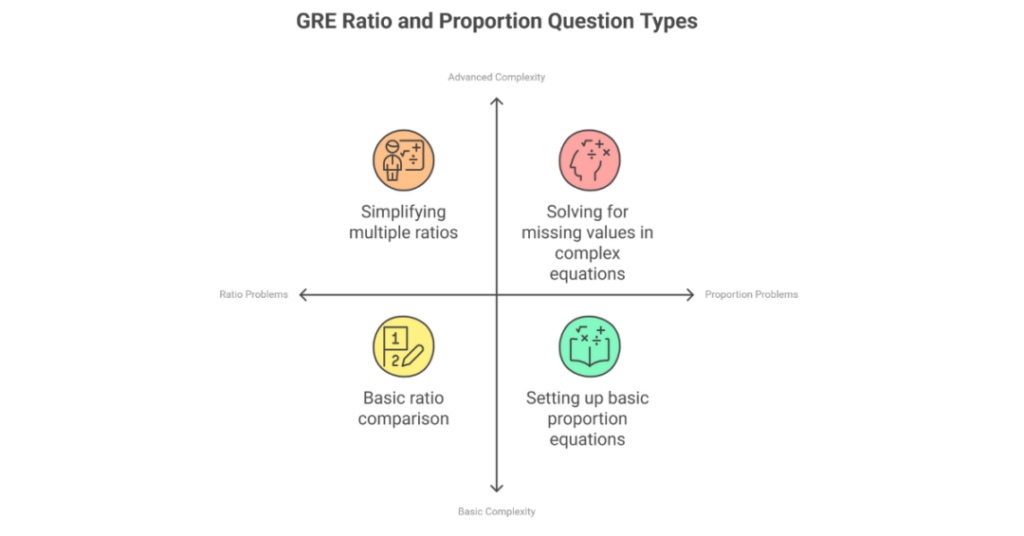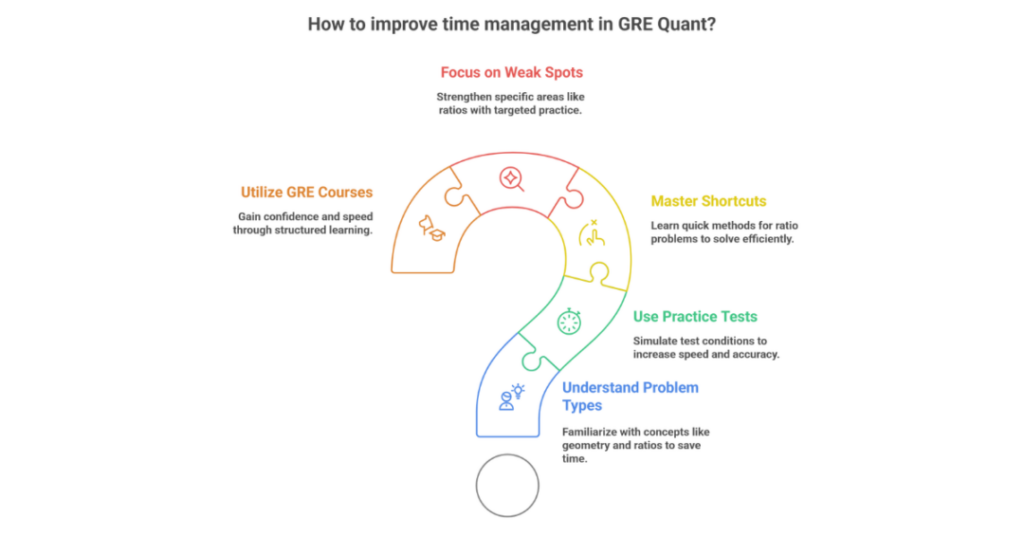5 June 2025
6 minutes read
How To Prepare For GRE Ratio and Proportion Questions (GRE Quantitative)?

Key Takeaways
- Mastering ratios and proportions is essential for acing the GRE Quant section.
- Regularly work on challenging problems to sharpen both speed and accuracy.
- Effective time strategies will boost your confidence and performance on test day.
Did you know that around 50% of the questions in the GRE Quantitative section involve concepts from Ratio and Proportion? Mastering this topic can be a game-changer for your score. However, despite its significance, many students find themselves overwhelmed by the complexity of these questions.
The challenge often stems from time constraints and the tricky nature of applying multiple mathematical principles in quick succession. Whether it’s about comparing quantities or solving word problems, it’s easy to get stuck, lose time, and ultimately miss out on crucial points. But don’t worry—facing these obstacles isn’t insurmountable. This is true even for GRE probability questions. With the right strategies and a clear understanding of key concepts, you can solve Ratio and Proportion questions efficiently and confidently.
What Are GRE Ratio And Proportion Questions?
GRE Ratio and Proportion questions test your ability to compare two quantities and find their relationships. These problems typically involve ratios, which express the relationship between two quantities, and proportions, which set two ratios equal to each other. GRE quant formulas can be a bit tricky. Mastering these concepts is crucial for success in the GRE Quantitative section, as they frequently appear in word problems.

In ratio problems, you’re often asked to simplify or multiply two ratios to find the relationship between multiple quantities. For proportion problems, you’ll work with equations that set two ratios equal, requiring skills in algebra to find missing values.
To excel, focus on practice questions that help you quickly identify relationships between numbers, simplify fractions, and manage the total number of terms. A solid test prep routine dedicating at least 1 hour a day as a GRE preparation time will sharpen your ability to spot patterns and solve efficiently within time constraints, especially under the pressures of the GRE Quant.
GRE Ratio And Proportion Practice Questions
Here’s a set of challenging GRE Ratio and Proportion practice questions designed to test your understanding and problem-solving skills, ideal for sharpening your performance in the GRE Quantitative section. Maybe create a GRE study plan for 6 months and start there.
Question 1: Ratio of Ages
A father is three times as old as his son. In 12 years, the sum of their ages will be 72 years. What is the present age of the son?
A) 12
B) 18
C) 24
D) 30
Solution:
Let the present age of the son be x. Then the father’s age is 3x.In 12 years, the son’s age will be x+12 and the father’s age will be 3x+123. The equation for the sum of their ages in 12 years is:
(x+12)+(3x+12)=72
Simplifying this:
4x+24=72
4x=72−24
4x=48
x=12
Answer: A) 12
Question 2: Mixing Solutions
A chemist has two solutions: Solution A contains 30% salt, and Solution B contains 70% salt. If the chemist wants to create 200 mL of a solution that is 50% salt, how many milliliters of Solution A and Solution B should be mixed together?
A) 100 mL of A and 100 mL of B
B) 60 mL of A and 140 mL of B
C) 140 mL of A and 60 mL of B
D) 80 mL of A and 120 mL of B
Solution:
Let x be the volume of Solution A and y be the volume of Solution B. We have two equations:
- x+y=200 (total volume)
- 0.3x+0.7y=0.5(200) (total salt content)
From the first equation, we can express y;
y=200−x
Substituting into the second equation:
0.3x+0.7(200−x)=100
0.3x+140−0.7x=100
−0.4x+140=100
−0.4x=100−140
−0.4x=−40
x=100
Now substituting back to find y:
y=200−100=100
Answer: A) 100 mL of A and 100 mL of B
Question 3: Ratio of Speeds
Two cars start from the same point and travel in opposite directions. Car A travels at a speed of 60 miles per hour, while Car B travels at a speed of 90 miles per hour. After how many hours will the ratio of the distance traveled by Car A to the distance traveled by Car B be 2:3?
A) 2 hours
B) 3 hours
C) 4 hours
D) 5 hours
Solution:
Let t be the time in hours. The distance traveled by Car A is 60t and by Car B is 90t.We set up the ratio:
60t/90t=2/3
Simplifying:
60/90=2/3
This is true for all tt, and we need to find tt such that the distances maintain this ratio.Since the ratio is already 2:3 at any time, we can choose t=3 hours to check:
- Distance by Car A: 60×3=180 miles
- Distance by Car B: 90×3=270 miles
The ratio is:
180/270=2/3
Answer: B) 3 hours
Question 4: Proportional Distribution
In a class of 40 students, the ratio of boys to girls is 3:5. If 10 more boys join the class, what will be the new ratio of boys to girls?
A) 2:5
B) 3:5
C) 4:5
D) 1:1
Solution:
Let the number of boys be 3x and the number of girls be 5x.From the ratio, we have:
3x+5x=40
8x=40
x=5
Thus, the number of boys is:
3x=15
And the number of girls is:
5x=25
Now, if 10 more boys join:
New number of boys=15+10=25
The number of girls remains the same at 25. The new ratio of boys to girls is:
25/25=1:1
Answer: D) 1:1
How To Get Better At GRE Quant Time Management?
Time management is crucial for excelling in the GRE Quantitative Reasoning section, where balancing speed and accuracy can make or break your score in GRE prep.

Here are some strategies to improve your timing while tackling the GRE:
Understand the problem types you’ll face
The GRE Quant features various concepts like geometry, ratios, and proportions. Questions like “What is the ratio of boys to girls in a class with 12 girls?” require quick thinking. You may need to find the ratio of men to women on a committee or combine two ratios like the ratio of apples to oranges and the ratio of red marbles in a jar. Understanding these concepts and being able to set up a proportion to solve for x can save valuable seconds on the test. Choose the right GRE maths preparation materials to help you with the process.
Use practice tests to get faster
Take full-length practice tests to simulate the real GRE experience. Aim to solve questions like the ratio of the number of boys in the class to girls in less than 1 minute per question. Some questions will involve using a simplified ratio, such as the ratio of men to women, while others may require more complex calculations like determining how long it will take a car traveling 60 miles per hour compared to one going 40 miles per hour. Timed tests will help you get accustomed to solving for the right answer under pressure. Understand the most important GRE math concepts as well.
Master shortcuts for ratio problems
To save time, quickly recognize when you need to solve ratio problems. For example, in the GRE, a ratio of men to women might appear as “the ratio of men to women is 3 to 2.” Knowing how to quickly simplify the ratio and solve the problem will help you handle questions efficiently. You might need to determine how many red marbles in a jar by using proportions or calculate the ratio of red to blue objects. Create a GRE math topic list and tick them off as you go through them.
Focus on specific weak spots in your prep
If you’re struggling with ratios, for instance, where you need to add the numerator or work with the numerator and denominator in a ratio like 3 to 2, concentrate on that area. Whether it’s right triangle problems or solving for x in word problems, flashcards can help reinforce these concepts. For instance, questions like “How many red marbles compared to blue marbles?” or “If a car is traveling at 60 miles per hour, how long will it take compared to 40 miles per hour?” will become easier with focused math practice questions. You can also create a GRE math formula flashcard to help you with the process.
Utilize GRE courses and study guides
Many GRE test courses offer targeted drills on problem areas like ratios. They’ll provide tips for questions where quantities are inversely proportional or require you to set up a proportion like “If the ratio of boys to girls is 3 to 2, and there are 12 boys, how many girls?” By using resources designed for millions of students, you’ll gain confidence and speed in working with ratios, allowing you to check your answer quickly and move on. Make sure your GRE conventions are pretty sold though.
Conclusion
Mastering GRE math Ratio and Proportion questions requires practice, patience, and a solid understanding of the underlying concepts. By incorporating these strategies and consistently working through challenging problems, you’ll improve both your accuracy and time management on the GRE Quantitative section. Remember, the key to success is regular practice and staying calm under pressure—keep refining your skills, and you’ll be well-prepared on test day!
Elevate Your GRE Prep: Join Ambitio’s GRE Bootcamp for Unmatched Success! Step up your preparation with our advanced resources and tools, designed to give you an edge over the competition.
FAQs
What is the best way to approach difficult ratio and proportion problems on the GRE?
Break the problem down into smaller parts and use simple steps like setting up proportions and cross-multiplying to solve for the unknown.
How much time should I spend practicing ratio and proportion questions for the GRE?
Aim for at least 1 hour a day, focusing on different types of ratio problems to build speed and familiarity with the concepts.
Can I use shortcuts to solve ratio and proportion questions quickly?
Yes! Simplifying ratios early and recognizing common patterns can save you valuable time during the exam.
How do ratios and proportions relate to other GRE Quant topics like algebra and geometry?
Ratio and proportion problems often require algebraic manipulation or appear in geometric contexts, like solving for sides in similar triangles.
Why are ratio and proportion questions so common on the GRE Quant section?
They test essential quantitative reasoning skills, which are fundamental in understanding relationships between numbers and quantities.
What should I do if I get stuck on a ratio or proportion problem during the test?
Skip the problem, mark it for review, and come back to it later—prioritize easier questions to manage your time effectively.
How can I improve my accuracy in ratio and proportion questions?
Double-check your setup of the proportion and make sure the ratios are simplified correctly before solving. Always verify your final answer by plugging it back into the original problem.

You can study at top universities worldwide!
Get expert tips and tricks to get into top universities with a free expert session.
Book Your Free 30-Minute Session Now! Book a call now




























